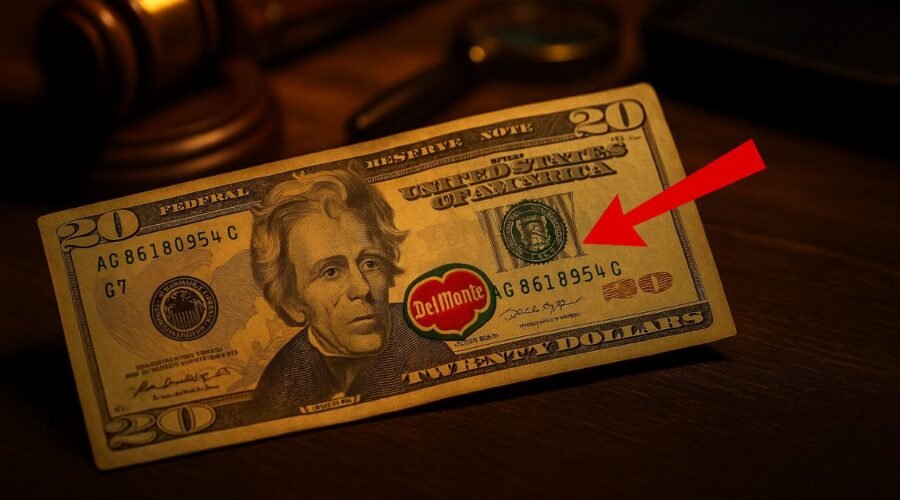Pocket Change Jackpot- How A Misprinted $20 Bill Sold For Six Figures
Have you ever wondered if the money in your wallet could be worth far more than its face value? That dream became reality when a single misprinted $20 bill shocked collectors and sold for an astonishing six-figure price.
Known as the “Del Monte” $20, this piece of currency transformed ordinary pocket change into one of the most famous error notes in U.S. history.
What Was the Misprint?
This legendary note was part of the 1996 $20 Federal Reserve series. During printing, a small Del Monte banana sticker accidentally landed on the bill. Instead of being removed, later print layers—including the green Treasury seal and part of the serial number—were printed over the sticker.
Collectors call this type of error a “retained obstruction”, and it is extremely rare because the obstructing object usually falls off. The sticker’s survival on the bill made this error unique, authentic, and highly valuable.
The Story of the “Del Monte” $20
- A college student in Ohio first discovered the note after withdrawing it from an ATM.
- The student sold it on eBay for around $10,000, marking the first big buzz around the bill.
- In 2006, the note was resold at auction for $25,300.
- The biggest shock came in 2021, when the bill went under the hammer at Heritage Auctions and achieved an incredible $396,000.
This made it the most expensive U.S. error banknote ever sold, breaking world records in numismatics.
Quick Facts
| Detail | Information |
|---|---|
| Denomination | $20 Federal Reserve Note (1996 series) |
| Error Type | Retained obstruction (Del Monte banana sticker) |
| Discovered | Withdrawn from an ATM by a college student |
| First Sale | Around $10,000 on eBay |
| 2006 Auction | $25,300 |
| Record Sale | $396,000 (2021 Heritage Auctions) |
| Notability | World record price for a U.S. error banknote |
Why Did It Sell for Six Figures?
- Rarity – Retained obstruction errors almost never survive. The presence of a real sticker from the printing process made it one-of-a-kind.
- Provenance – The note’s journey from an ATM to eBay and then to world-famous auctions added to its story.
- Collector Demand – Error notes are already highly collectible, but this example had extraordinary appeal.
- Publicity – Media coverage helped turn the “Del Monte” $20 into a household name in the world of rare currency.
Are Other Misprinted Bills Valuable?
While the Del Monte note is exceptional, other error notes can also command strong prices. Examples include:
- Mismatched serial numbers – Can sell for hundreds or even thousands.
- Shifted seals or numbers – Collectors pay more when the misprint is obvious and dramatic.
- Ink smears or folds – Some bring premiums if certified by professional graders.
The value depends heavily on condition, rarity, and authentication.
How to Spot a Valuable Error Bill
- Look closely at the face: Check if seals or numbers overlap with something unusual.
- Compare serials: Both numbers must be identical—any mismatch could signal a valuable misprint.
- Preserve condition: Don’t fold or damage potential finds. Place them in protective sleeves.
- Seek certification: Reputable grading services confirm authenticity and help maximize resale value.
The Del Monte $20 bill proves that even an ordinary note can become a jackpot worth hundreds of thousands.
While not every misprinted bill is a goldmine, paying attention to details like serial numbers, printing shifts, and retained obstructions could reward you with a small fortune.
The next time you withdraw cash from an ATM, remember: your change might hold a hidden treasure.
FAQs
Why was the Del Monte $20 so valuable?
Because it had a genuine Del Monte sticker printed over with official Treasury markings, making it an authentic and rare error.
Can I find valuable misprinted bills in circulation today?
Yes, although rare. Misprinted bills still surface occasionally, and collectors are always looking for unique errors.
How should I sell an error note?
Protect it in a sleeve, get it professionally graded, and sell through reputable auction houses or trusted currency dealers.

Leave a Reply Cancel reply